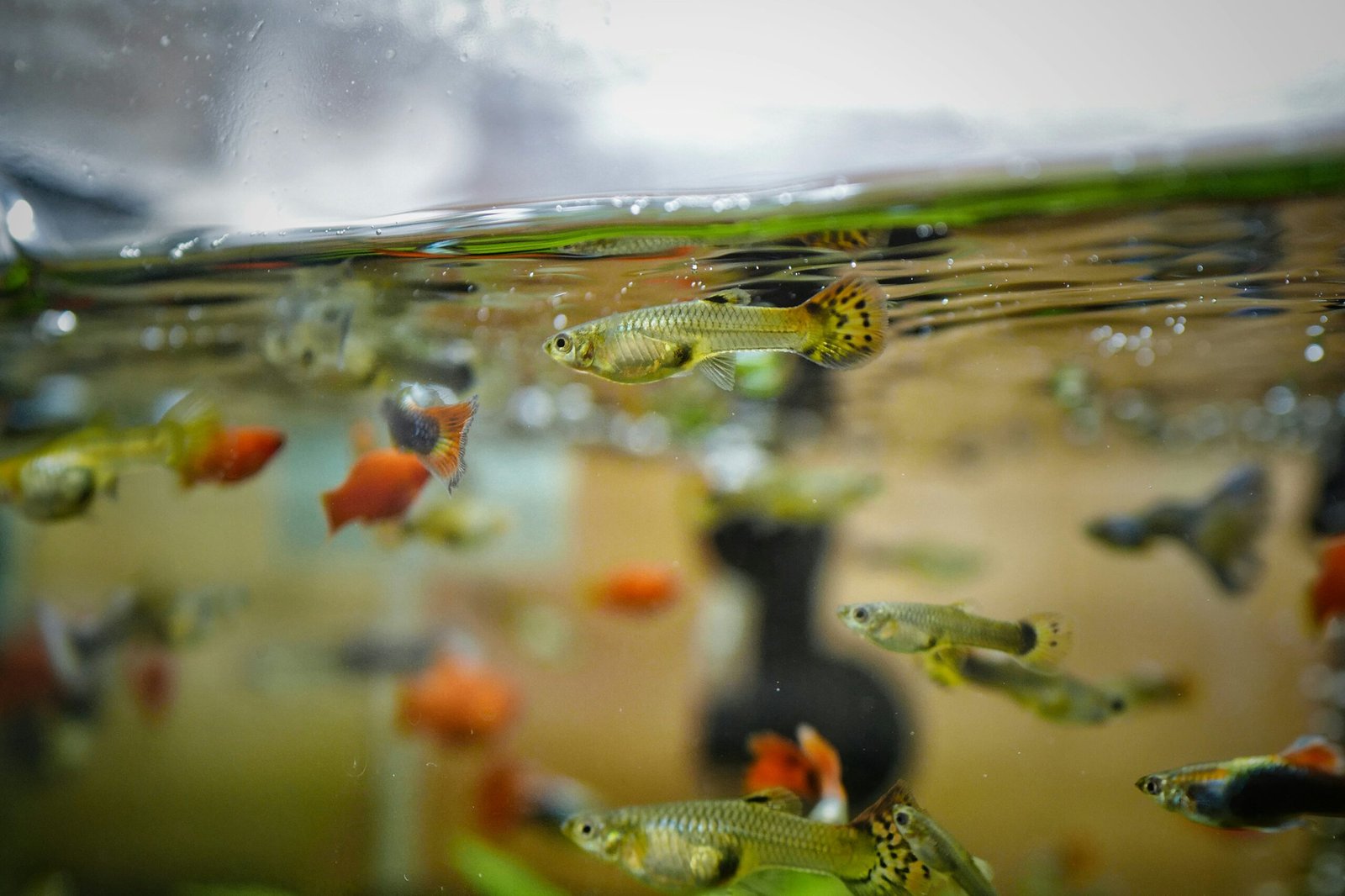
What is the Nitrogen Cycle?
The nitrogen cycle is a fundamental process in maintaining a healthy aquarium ecosystem. It involves the transformation of nitrogen compounds, starting with ammonia, progressing to nitrite, and finally to nitrate. This cycle is critical as it helps in converting toxic substances into less harmful forms, ensuring a safe environment for aquatic life.
In a new tank, the nitrogen cycle begins when waste products, uneaten food, and decaying organic matter introduce ammonia into the water. Ammonia is highly toxic to fish and other aquatic organisms, even at low concentrations. However, nitrifying bacteria play a crucial role in converting ammonia into nitrite, another toxic compound, but less harmful than ammonia.
The second stage of the nitrogen cycle involves the conversion of nitrite to nitrate. This transformation is carried out by a different group of nitrifying bacteria. Nitrate is far less toxic compared to ammonia and nitrite, and at low to moderate levels, it is usually well-tolerated by fish. However, excessive nitrate can still be harmful over time, necessitating regular water changes to keep its concentration in check.
Understanding the nitrogen cycle helps aquarium enthusiasts manage new tank syndrome, a common issue where ammonia and nitrite levels spike due to an unestablished nitrogen cycle. Regular testing using a reliable test kit is essential to monitor these levels and ensure they remain within safe limits.
Establishing the nitrogen cycle in a new tank can take several weeks. During this time, it’s crucial to introduce fish gradually and monitor water parameters closely. Patience and careful management during this period will lead to a stable and healthy aquarium environment, benefiting both the aquatic inhabitants and the aquarist.
Why the Nitrogen Cycle is Crucial for a Healthy Aquarium
The nitrogen cycle is a fundamental process that ensures a stable and healthy environment within an aquarium. This biological cycle involves the conversion of toxic compounds like ammonia into less harmful substances, ultimately creating a safe habitat for fish and other aquatic life. Understanding and properly managing the nitrogen cycle is essential to prevent the build-up of toxins that can result in severe health issues or even death for aquarium inhabitants.
In a newly established tank, organic waste from fish, uneaten food, and decaying plant matter produces ammonia. Ammonia is extremely toxic to fish and can cause immediate harm if not managed properly. Through the process of nitrification, beneficial bacteria convert ammonia into nitrite, another toxic compound. However, another group of bacteria further converts nitrite into nitrate, which is relatively less harmful and can be removed through regular water changes and plant absorption.
New tank syndrome is a common challenge faced by many aquarium enthusiasts, arising from the lack of an established nitrogen cycle. Without a balanced cycle, ammonia and nitrite levels can spike, leading to toxic conditions. These spikes can cause symptoms like lethargy, gill damage, and even mortality among fish. To prevent such scenarios, it is crucial to establish and maintain a healthy nitrogen cycle from the outset.
Regular monitoring using a reliable test kit is essential to keep track of ammonia, nitrite, and nitrate levels. Early detection of any imbalance allows for timely interventions, such as water changes or the addition of beneficial bacteria, to restore equilibrium. By understanding the nitrogen cycle and its critical role in the aquarium ecosystem, hobbyists can prevent common issues like ammonia poisoning and nitrite spikes, ensuring a thriving and stable aquatic environment.
The Nitrogen Cycle and Starting a New Tank
Establishing the nitrogen cycle in a new aquarium is a fundamental step to creating a healthy environment for aquatic life. The nitrogen cycle involves the conversion of ammonia into nitrite and then into nitrate, facilitated by beneficial bacteria. Understanding and completing this cycle before introducing fish is crucial to prevent exposing them to toxic levels of ammonia and nitrite.
When starting a new tank, the cycle can be initiated using several methods. One effective approach is to introduce existing filter media from an established aquarium. This media already contains the necessary bacteria to kickstart the nitrogen cycle. Alternatively, adding a source of ammonia, such as pure ammonia or fish food, can also help establish the cycle. The added ammonia acts as a food source for the bacteria, encouraging their growth.
Patience is essential during this process as the cycle typically takes several weeks to complete. Initially, ammonia levels will rise as it accumulates from the added source. Over time, beneficial bacteria will convert the ammonia into nitrite, which is also toxic to fish. Eventually, another group of bacteria will transform nitrite into nitrate, which is less harmful and can be controlled through regular water changes.
To monitor the progress of the nitrogen cycle, it is advisable to use a test kit to measure the levels of ammonia, nitrite, and nitrate in the water. Regular testing will help determine when the tank is ready for fish. Only when ammonia and nitrite levels consistently read zero, and nitrate levels are manageable, is it safe to introduce fish into the aquarium.
By following these steps and understanding the nitrogen cycle, new aquarium owners can ensure a healthy environment for their fish. Skipping or rushing this process can lead to new tank syndrome, where fish are exposed to harmful toxins, resulting in stress, illness, or even death. Therefore, establishing the nitrogen cycle properly is a critical foundation for any successful aquarium.
Monitoring the Nitrogen Cycle: The Role of Test Kits and Bacteria Growth
Maintaining a healthy aquarium necessitates a thorough understanding of the nitrogen cycle and the pivotal role of regular testing. Test kits designed for aquariums are indispensable tools for measuring the levels of ammonia, nitrite, and nitrate, which are key indicators of the nitrogen cycle’s progression. Without proper monitoring, an imbalance in these parameters can lead to new tank syndrome, a condition that can be detrimental to aquatic life.
Using a test kit involves collecting a water sample from the aquarium and adding reagents that react with specific nitrogen compounds, resulting in a color change. Each test kit typically includes a color chart to help interpret the results. Regularly measuring ammonia levels is crucial, as ammonia is highly toxic to fish. Ideally, ammonia should be undetectable in a well-established tank. Elevated levels indicate that the tank is still in the early stages of the nitrogen cycle or that there is an imbalance in the system.
As the nitrogen cycle progresses, ammonia is converted to nitrite by nitrifying bacteria. Nitrite is also harmful to aquatic organisms, and its presence signifies that the cycle is ongoing. Therefore, it’s essential to monitor nitrite levels until they drop to zero. Finally, nitrite is converted to nitrate by another group of nitrifying bacteria. Nitrate is less toxic and can be tolerated in higher concentrations, but regular water changes are necessary to keep nitrate levels in check.
The growth of nitrifying bacteria is a gradual process that occurs on all surfaces within the aquarium, including the filter sponge material. Over time, these bacterial colonies develop and become more efficient at processing ammonia and nitrite, thus supporting a stable and healthy environment. Ensuring adequate surface area for bacterial colonization, such as through the use of bio-media in filters, can further enhance the effectiveness of the nitrogen cycle.
In conclusion, consistent use of test kits to monitor ammonia, nitrite, and nitrate levels, coupled with fostering the growth of nitrifying bacteria, is essential for maintaining a balanced nitrogen cycle and preventing new tank syndrome. By diligently tracking these parameters, aquarists can create a thriving aquatic habitat that promotes the well-being of their fish and other aquatic inhabitants.
